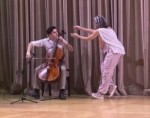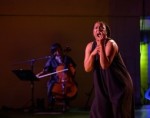
Kulu Mele Celebrates Maturation and Fellowship—Past, Present, Future
by Caitlin Green
It’s golden hour. A projection of a sunset meets the eye from across a body of water which accentuates its warm, tangerine glare. In the foreground, village people gather, attending to their daily tasks—sorting and washing fabrics, carrying baskets overhead, mingling and exchanging warm greetings in passing. The children are playing double-dutch, helping with errands, or adding playful mischief to the scene. At the first strike of percussion, a duet emerges from the crowd as villagers disperse, marking the first of ten captivating dances.
In this strikingly vibrant and endearing narrative honoring a boy’s maturation to manhood, Kulu Mele African Dance & Drum Ensemble's Rite of Passage nods to the plight of masculinity as much as it pays tribute to the socialsphere of support and nurturance the journey to masculinity requires. The story thrums with scenes of intergenerational fellowship, conveying the loving guidance and celebration associated with this distinct transition from youth to adulthood. Rite of Passage represents infectious and explosively joyous transformation through dance and drum.

Photo: Jaci Downs
Using instruments such as djembe and krin drums, the kora, the balafon, and the shekere, among others, the ensemble engages West African tradition (primarily that of Guinea and Mali) with the rhythms they activate and the stylized dances often performed as ritual in various occasions and gatherings. Brilliantly colored, bold-print patterned clothing adorn each dancer and musician, and match the brightness of their facial expressions. When the ensemble dances together their movement elevates the music and vice versa in a feedback loop. They generate vitality with a rhythmic catharsis of body and instrument that welcomes viewers to move; almost dares us not to. Joining as a participant in the jubilation was inevitable. The audience reciprocated through howls, claps, waves, words of affirmation, and of course, dance— drawn into the ceremonial elation and energizing percussions, we moved together.
The work displayed multifaceted talents. Performers synthesized the roles of musician, dancer, actor and athlete. They told stories through short and silent theatrical skits between dances, and in the choreography. Through agile footwork and spirited jumps, often under the watchful eye of his elders and community, the boy initiate (Yusuf Young) exemplified both a child-like wonder and warrior spirit; appearing determined and passionate about his becoming. Young’s character learns to hunt through mentorship of an elder (John E. Wilkie) in a number called Sofa, meaning “warrior” in the Malinke language. The following number, titled Dansa/Sunu, enlivens rhythms associated with a competition dance from the Kassounke people of Southern Mali. The rigor required in the dance, and many others performed throughout the show, lends to steady and continuous footwork that keep up with the quick meter of the drums.
The endurance and precision that these dances demand is impressive, as it is a performance that engages the body in its entirety, and in a consistent pattern of tension release and recollection. I wrote in my notes, “I know they gotta be tired!”with about seven exclamation points, only 10 minutes into the 90-minute program. Yet the dancers didn’t retire their pleasant expressions, and the collective energy never reached a plateau. The work was impressively wonderful to witness, and to join in. It seemed genuinely enjoyed both by those on and off stage.

Photo: Jaci Downs
Rite of Passage was embedded with tradition and intention. The performance was both aesthetically grand and deeply threaded with the relics of its pioneers. Upon entering the Performance Garage, the audience received a program filled with information about the origin of each traditional dance and song. While preserving their history, Kulu Mele also looked ahead to future generations through this lineage. The company welcomed donations toward their children’s arts education program, Omo Kulu Mele, in the opening remarks, and emphasized the importance of sharing these gifts with the youth. It was evident that the visual and sonic representation of the craft would be incomplete without the acknowledgement of its past, present and future influence. Kulu Mele describes their mission and practice as being “inspired by the voice of their ancestors… to preserve, present and perpetuate the dance and music of West Africa and the African Diaspora”. The homage in the work was irrefutable, and camaraderie appeared essential in resourcing the young initiate with the tools and environment needed to foster an integrated sense of self and community. The final cypher crystallized this. It felt like a reminder that holding space for one to come to their fullest expression of self is an accomplishment that becomes everyone’s victory.
Rite of Passage, Kulu Mele African Dance and Drum Ensemble, Performance Garage, Nov. 26 & 27.
By Caitlin Green
December 9, 2022









